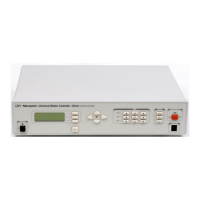In the case of a DC motor, adjusting the PID parameters to get a softer
response will reduce the velocity ripple but care must be taken not to
negatively affect other desirable motion characteristics.
5.2.14 Velocity Regulation
In some applications, for example scanning, it is important for the
velocity to be very constant. In reality, there are a number of factors
besides the controller that affect the velocity.
As described in the Minimum Velocity definition, the speed plays a
significant role in the amount of ripple generated, especially at low
values. Even if the controller does a perfect job by running with zero
following error, imperfections in the mechanics (friction, variation,
transmission ripple, etc.) will generate some velocity ripple that can
be translated to Velocity Regulation problems.
Depending on the specific application, one motor technology can be
preferred over the other.
As far as the controller is concerned, the stepper motor version is the
ideal case for a good average Velocity Regulation because the motor
inherently follows precisely the desired trajectory. The only problem
is the ripple caused by the actual stepping process.
The best a DC motor controller can do is to approach the stepper
motor's performance in average Velocity regulation, but it has the
advantage of significantly reduced velocity ripple, inherently and
through PID tuning. If the DC motor implements a velocity closed
loop through the use of a tachometer, the overall servo performance
increases and one of the biggest beneficiary is the Velocity
Regulation.
5.2.15 Maximum Acceleration
The maximum Acceleration is a complex parameter that depends as
much on the motion control system as it does on application
requirements. For stepper motors, the main concern is not to loose
steps (or synchronization) during the acceleration. Besides the motor
and driver performance, the load inertia plays a significant role.
For DC motor systems the situation is different. If the size of the
following error is of no concern during the acceleration, high
Maximum Acceleration values can be entered. The motion device will
move with the highest natural acceleration it can (determined by the
motor, driver, load inertia, etc) and the errors will consist of just a
temporary larger following error and a velocity overshoot.
In any case, special consideration should be given when setting the
acceleration. Through in most cases no harm will be done in setting a
high acceleration value, avoid doing so if the application does not
5-12 Section 5 – Motion Control Tutorial

